Editor’s note: This story has been updated to reflect values from the latest patch.
Teamfight Tactics, Riot Games’ take on the Auto Battler (also known as Auto Chess) genre, has been a huge hit with both players and viewers on Twitch. It’s a strategy game where players draft units, place them on a board as a team, and compete against seven other players.
The first time you play TFT, you might find it frustratingly complex, but you can actually break the game down into four key areas: Champions, Items, Economy, and Positioning.
This guide will help you understand these basics to give you a good foundation to start playing the game.

Table of Contents
Rules of the game
In TFT, the goal is to be the last team standing. Players fight with teams made up of different champions equipped with various items.
Each game has three types of rounds: Player vs Player (PvP), Player vs Environment (PvE) and the carousel round.
Teams fight against each other in the PvP round, and against NPCs during PvE rounds. Every player begins with 100 health, taking damage when a round is lost.
During the carousel round, players pick champions and items from a public pool of available champions, adding them to their team.
The game begins with a carousel round. This is followed by three PvE rounds which provide time to build up the team before the 4th round when PvP rounds begin.
Every round that isn’t a carousel or a PvE round is a PvP round.
Here’s when you can expect each round to happen:
| Round | Encounter |
| 0 | Carousel |
| 1 | 2 Melee Minions |
| 2 | 2 Melee Minions / 1 Ranged Minion |
| 3 | 2 Melee Minions / 4 Ranged Minions |
| 6 | Carousel |
| 9 | 3 Krugs |
| 12 | Carousel |
| 15 | 4 Murk Wolves / 1 Greater Murk Wolf |
| 18 | Carousel |
| 21 | 4 Raptor / 1 Crimson Raptor |
| 24 | Carousel |
| 27 | 1 Dragon |
| 30 | Carousel |
| 33 | 1 Mech Cannon / 4 Mech Melee |
| 36 | Carousel |
| 39 | 1 Rift Herald |
| 42 | Carousel |
| 45 | 1 Elder Dragon |
After every round, players are rewarded with gold. Gold is used to purchase and upgrade units or to level up. Units are placed on the battlefield after being purchased.
Units are upgraded by purchasing multiple copies of the same unit. Units also have different origins and classes that provide various bonuses.
When a player runs out of health, they are out of the game.
Champions, Origins, and Classes
There are a total of 53 champions in TFT as of patch 9.13. All champions have at least one origin and a class. Understanding how origins and classes work to create effective synergy is the backbone of any strong team.
Origins
A champion’s origin describes where they come from, or where their allegiance lies. There are currently 13 origins and by placing the right amount of units with the same origins on the board, the origin buff will be activated.
Demon
Demons have a chance on-hit to deplete the target’s current mana and deal true damage equal to the mana depleted.
- 2 Demons: 25%
- 4 Demons: 50%
- 6 Demons: 85%
Champions: Aatrox, Brand, Elise, Evelynn, Morgana, Swain, Varus

Dragon
When two Dragons are in play, all Dragons are immune to magic damage.
Champions: Aurelion Sol, Shyvana

Exile
Exiles start combat with a shield equal to 100% of maximum health when not placed adjacent to an ally. The shield does not scale with ability power.
Champion: Yasuo

Glacial
Glacials have a chance on-hit to stun for 2 seconds.
- 2 Glacials: 20%
- 4 Glacials: 30%
- 6 Glacials 45%
Champions: Anivia, Ashe, Braum, Lissandra, Sejuani, Volibear

Imperial
A select number of Imperials deal double damage.
- 2 Imperials: One random Imperial
- 4 Imperials: All Imperials
Champions: Darius, Draven, Katarina, Swain

Ninja
- Exactly 1 Ninja: This Ninja gains 40% attack damage.
- Exactly 4 Ninja: All Ninjas gain 80% attack damage.
Champions: Akali, Kennen, Shen, Zed

Noble
Grants 100 armor and basic attacks restore 35 health on-hit to the following:
- 3 Nobles: A random ally
- 6 Nobles: The whole team.
Champions: Fiora, Garen, Kayle, Leona, Lucian, Vayne

Phantom
While 2 Phantoms are in play, a random enemy will begin combat with 100 health. Works against epic monsters, but deals less damage.
Champions: Karthus, Kindred, Mordekaiser

Pirate
While 3 Pirates are in play, you begin each Player vs Player (PVP) round with a chest that grants between 0 and 4 gold, with an average value of 1.6 gold per chest.
Champions: Gangplank, Graves, Miss Fortune, Pyke, Twisted Fate

Robot
Robots begin combat with full mana.
Champions: Blitzcrank

Void
While 3 Voidlings are in play, your team gains 50% armor penetration.
Champions: Cho’Gath, Kassadin, Kha’Zix, Rek’Sai

Wild
Wildlings generate Fury on-hit, up to 5. Each stack gives 8% attack speed.
- 2 Wildlings: Fury benefits all allied Wildlings.
- 4 Wildlings: Fury benefits all allies.
Champions: Ahri, Gnar, Nidalee, Rengar, Warwick

Yordle
Yordles have a chance to dodge enemy attacks
- 3 Yordles: 25%
- 6 Yordles: 60%
Champions: Gnar, Kennen, Lulu, Poppy, Tristana, Veigar

In general, you should focus on building around a single origin in your team. Juggling more than two origins will lead to a weak team. There are a limited number of champions and the team’s classes to balance too.
Certain origins are useful early game, although they fall off as the game progresses. Nobles and Pirates are great starting origins to focus on. Nobles provide excellent durability while Pirates give your gold a boost to fund your team.
For example, if you see Garen, Vayne or Fiora, purchase them immediately because they are the three Noble champions who appear during the early game and builds the Noble buff quickly.
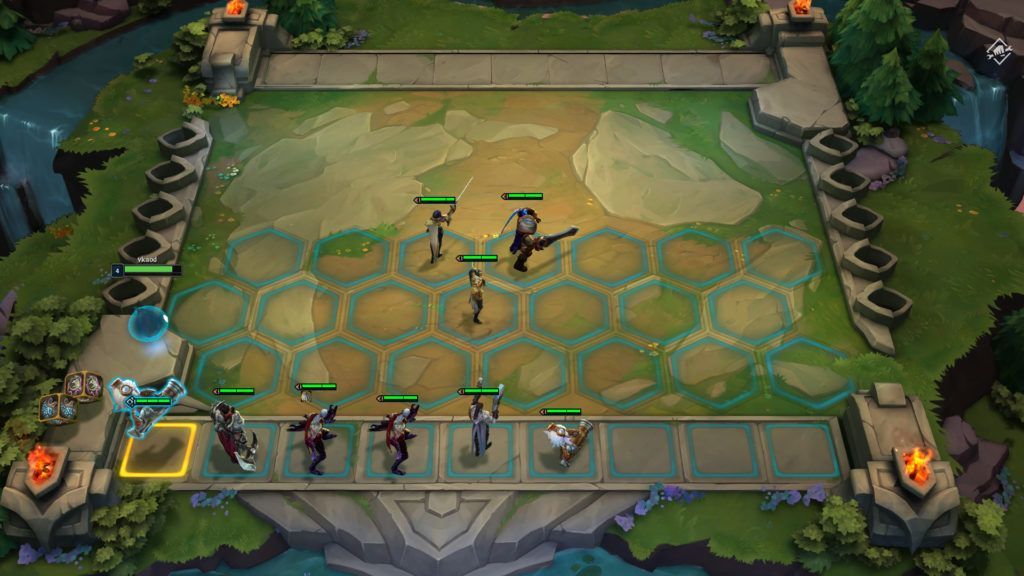
Screenshot by Lim Ming Dao/ONE Esports
The Noble defensive buff helps Garen and Fiora buy time for Vayne to wipe out the enemy.
As the game progresses, tougher champions will start to appear. Their higher damage also means Nobles start to fall off. It’s important to transition your team to adapt.
Glacials and Imperials are great choices for medium-to-late game. Glacials provide solid crowd-control abilities, freezing teams in place while Imperials provide great damage to quickly grind down the enemy.
The key to this team is to build around Draven.
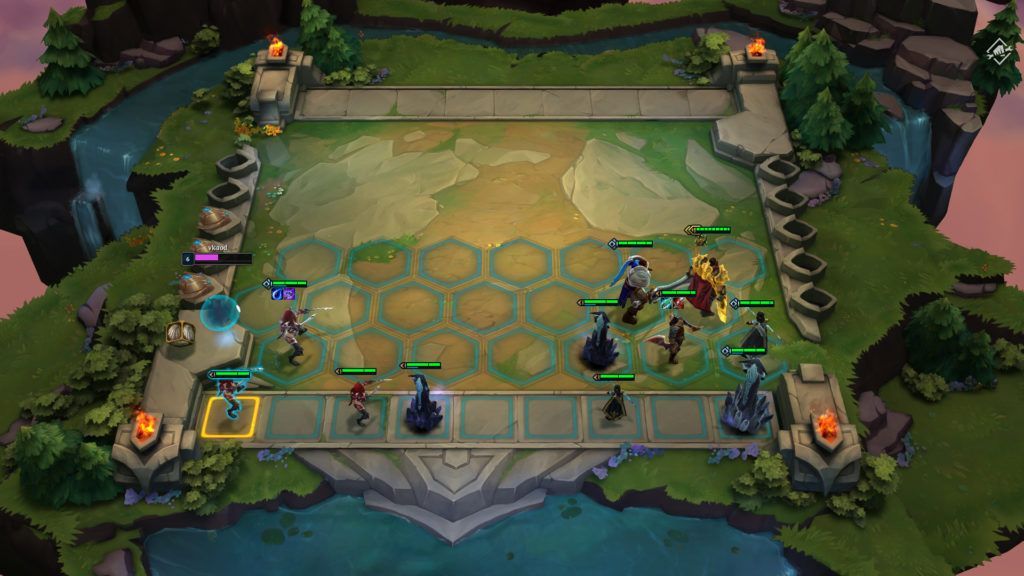
Screenshot by Lim Ming Dao/ONE Esports
The Glacials will crowd control the enemy team with their buffs while Draven easily slaughters the enemy from the backline with the Imperial buff.
Keeping an eye on the enemy team’s composition is also key to winning. For example, if the enemy has a team that is built around sorcerers, forming a team of Demons who can burn mana would be an excellent counter.
Classes
A champion’s class describes how they fight. Classes should be your primary focus as they inform you how to build a balanced team. There are ten different classes.
Assassin
Passive: At the start of combat, Assassins stealth for a short duration and jump behind the farthest enemy.
Synergy: Assassins have bonus critical strike damage
- 3 Assassins: +150%
- 6 Assassins: +350%
Champions: Akali, Evelynn, Katarina, Kha’Zix, Pyke, Rengar, Zed

Blademaster
Blademasters have a 45% chance to perform a multi-attack.
- 3 Blademasters: Double strike
- 6 Blademasters: Triple strike
Champions: Aatrox, Draven, Fiora, Gangplank, Shen, Yasuo

Brawler
Brawlers gain additional maximum health.
- 2 Brawlers: +300
- 4 Brawlers: +700
Champions: Blitzcrank, Cho’Gath, Rek’Sai, Volibear, Warwick

Elementalist
Passive: Elementalists’ basic attacks grant twice as much mana.
Synergy: Beginning combat with 3 Elementalists will summon an Elemental with 2,500 health and 100 attack, adjacent to one of your Elementalists, in the closest empty hex to an enemy. This effect will fail if there are no valid spaces.
Champions: Anivia, Brand, Kennen, Lissandra

Guardian
Beginning combat with 2 Guardians will grant 40 armor to all units that start adjacent to a Guardian. This effect can stack any number of times.
Champions: Braum, Leona

Gunslinger
Gunslingers have a 50% chance for their attacks to hit additional enemies.
- 2 Gunslingers: One additional random enemy.
- 4 Gunslingers: Two additional enemies in range.
Champions: Gangplank, Graves, Lucian, Miss Fortune, Tristana

Knight
Knights ignore a flat amount of damage from basic attacks.
- 2 Knights: 20
- 4 Knights: 40
- 6 Knights: 80
Champions: Darius, Garen, Kayle, Mordekaiser, Poppy, Sejuani

Ranger
Every 3 seconds, Rangers have a chance to gain double attack speed for 3 seconds.
- 2 Rangers: 25%
- 4 Rangers: 65%
Champions: Ashe, Kindred, Varus, Vayne.

Shapeshifter
While 3 Shapeshifters are in play, activating their Special Ability will grant +60% maximum health, as well as healing for the amount gained.
Champions: Elise, Gnar, Nidalee, Shyvana, Swain

Sorcerer
Passive: Sorcerers’ basic attacks grant twice as much mana.
Synergy: Sorcerers grant ability power to their team.
- 3 Sorcerers: +35
- 6 Sorcerers: +100
Champions: Ahri, Aurelion Sol, Karthus, Kassadin, Lulu, Morgana, Twisted Faste, Veigar

In the early stages of the match, a safe move is to build a balanced team. That means having one or two front line tanks and two damage dealers.
A basic early game choice would be knights for tanks and assassins, gunslingers or rangers for damage. Alternatively, having sorcerers for damage works too.
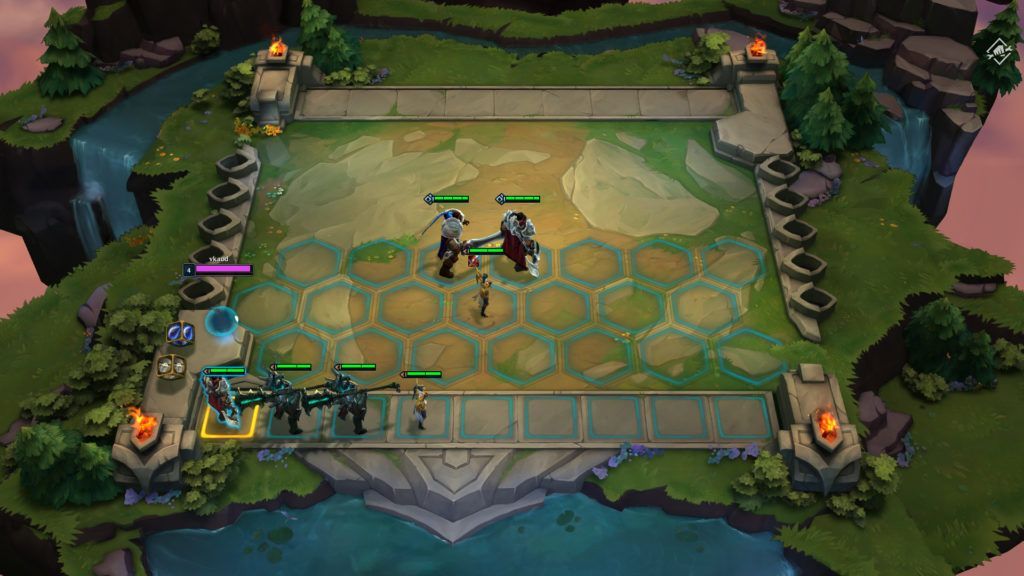
Screenshot by Lim Ming Dao/ONE Esport
As the match progresses, it’s possible to break away from this balance. For example, committing to a sorcerer line-up with only one knight.
By using the sorcerer buff with six sorcerers on his team, Disguised Toast maximized his damage to a level where he did not need that many tanks.
The best teams are created by finding a balance between origins and classes. Combining buffs and building synergy is the secret to dominating the field.
For example, the ranger/glacial combo is extremely strong. This combo focuses on Ashe as the main damage dealer. With two rangers and four glacials, the increased speed of the ranger buff would help to trigger the glacial stun buff on Ashe.
The other glacial units also continuously stun the enemy, buying time for Ashe to mop everyone up.
Credit: Scarra
Items
Creating good synergy is the backbone of any good team but item usage sets apart the best of the best.
Items are obtained from the carousel round or as random drops from killing minions during PvE rounds. If items aren’t dropped during a PvE round, gold will be dropped instead.
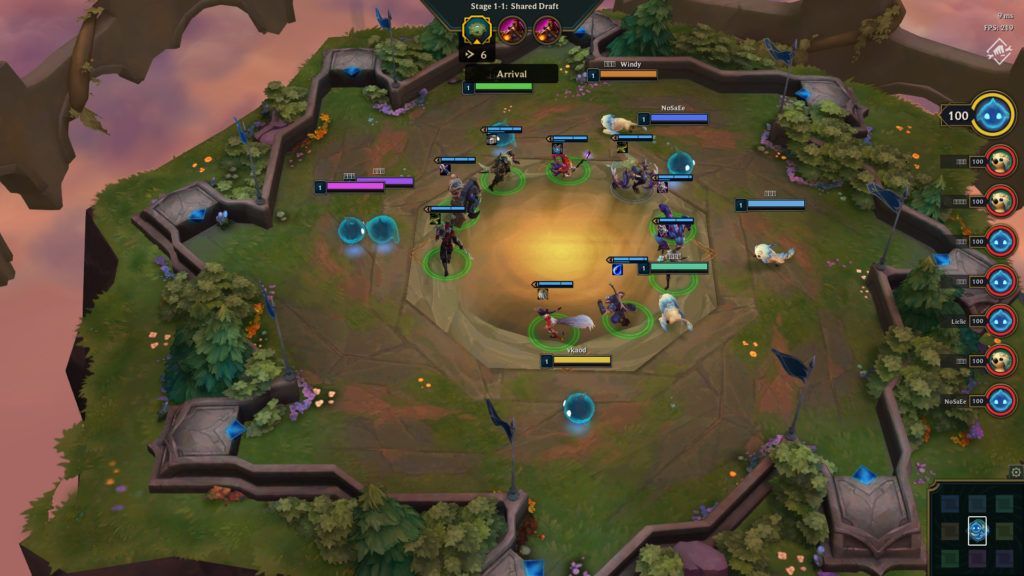
Credit: Lim Ming Dao/ONE Esports
Items are equipped on Champions to increase their stats and give additional effects. Each Champion can hold a maximum of three items.
There are eight basic items. Each of these can be combined with each other to create an upgraded item.
With 36 possible upgraded items, it’s important to remember the combination for each item. Upgraded items cannot be broken down into their basic parts so use your items wisely.
Typically, you would want to equip offensive items on your damage dealers, defensive items on your tanks and mana items on your crowd control units.
The Guinsoo’s Rageblade is an example of a great item for any physical damage dealer.
In this play, Disguised Toast equipped Volibear, his damage dealer, with Guinsoo’s Rageblade and Bloodthirster to increase its attack speed and have health regeneration. A good item combination for most physical damage dealers.
Another example of a great item for certain types of champions is the Spear of Shojin. The Spear of Shojin helps champions generate mana quickly, a perfect item for champions who rely on their abilities to control the enemy team.
Items can be stacked, so the enemy Pyke with two Spear of Shojins is able to cast his ability after two hits, taking out Disguised Toast’s team.
Never combine items before a PVE round. Minions have a chance of dropping items so waiting until after the PVE round when all possible items have been collected is the best.
| Round | Enemies |
| 1 | 2 melee minions |
| 2 | 2 melee minions / 1 ranged minion |
| 3 | 2 melee minions / 2 ranged minions |
| 9 | 3 Krugs |
| 15 | 1 Greater Murk Wolf / 4 Murk Wolves |
| 21 | 1 Crimson Raptor / 4 Raptors |
| 27 | 1 Dragon |
| 33 | 2 Mech Cannon / 4 Mech Melee |
| 39 | 1 Rift Heral |
| 45 | 1 Elder Dragon |
Economy
Gold is needed to build a good team. Managing your gold in TFT is just as important for winning.
Gold has three purposes: buying new champions, re-rolling for champions or buying experience points.
Champions are split across five tiers. A tier one champion costs one gold and the cost of a champion increases by one gold per tier. That means a tier two champion costs two gold, and so on, until five gold.
Re-rolling for new champions costs two gold. Re-rolling clears the entire store so purchase champions you want before re-rolling for new ones.
Buying experience points costs four gold, which grants four experience points (XP). As you level up, you’ll be able to place more champions on the field. For example, at level five, you will be able to place five champions.
| Legend Level | Requirement | Unit Cap |
| 1 | Start of the game | 1 |
| 2 | After the first wave | 2 |
| 3 | 2 XP | 3 |
| 4 | 6 XP | 4 |
| 5 | 10 XP | 5 |
| 6 | 18 XP | 6 |
| 7 | 30 XP | 7 |
| 8 | 46 XP | 8 |
| 9 | 64 XP | 9 |
With the exception of the first four rounds, you gain a base of five gold each round. There’s an additional one gold if you win the round and winning or losing streaks also provide bonus gold of up to three per round.
Every multiple of 10 gold gives you interest, up to five gold. This means with 20 gold, there is two gold interest up to the maximum interest of 50 gold.
Interest is calculated at the start of every round. The trick behind maximizing your gold is to restrict spending so that the final gold is always a multiple of 10, if not one or two gold higher before the start of the round.
A tip would be to purchase champions you may not find useful at the moment. Champions are always sold at the same cost they are bought. There is no harm in keeping a stock of champions as they can be sold back without a loss.
Positioning
The final part to mastering TFT is positioning. Even the best champion with the best items will die if poorly placed.
TFT’s battlefield is six rows of seven hexagons. Each champion takes up one hexagon space. Players can place champions anywhere on their side of the field.
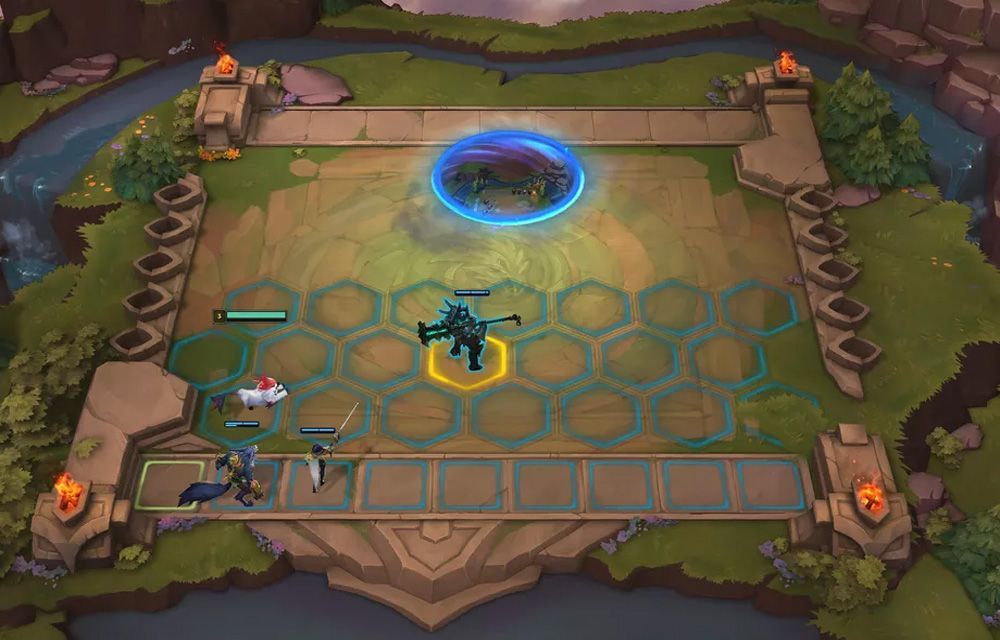
The general tactic behind positioning is to place units in a formation that protects the damage dealers. Tanks should engage the enemy first, followed by your melee damage dealer. This is followed by your ranged damage dealer in the backline.
During the early game, placing units in the middle of the board in a Y formation is generally a sound strategy.

Most players in TFT place units on either the left or right side of the board. Placing your units in the center of the board allows flexibility in engaging either left or right formation players.
The Y formation ensures that the ranged damage dealer is safe from enemies. The backline can run interference if the enemy has an assassin. Rather than attacking your ranged unit, the assassin will now attack your backline instead, keeping your ranged unit safe.
As the game progresses, how you position your units depends on the type of team you have while still following the general rule of protecting your damage dealers.
An exception to this rule is with an assassin team. When running an assassin team, the strategy is to pull the enemy front line away from their backline as much as possible to open up space for your assassins.
To do this, place the tanks on the furthest row away from the enemy. Follow up by surrounding the tanks with the assassins.
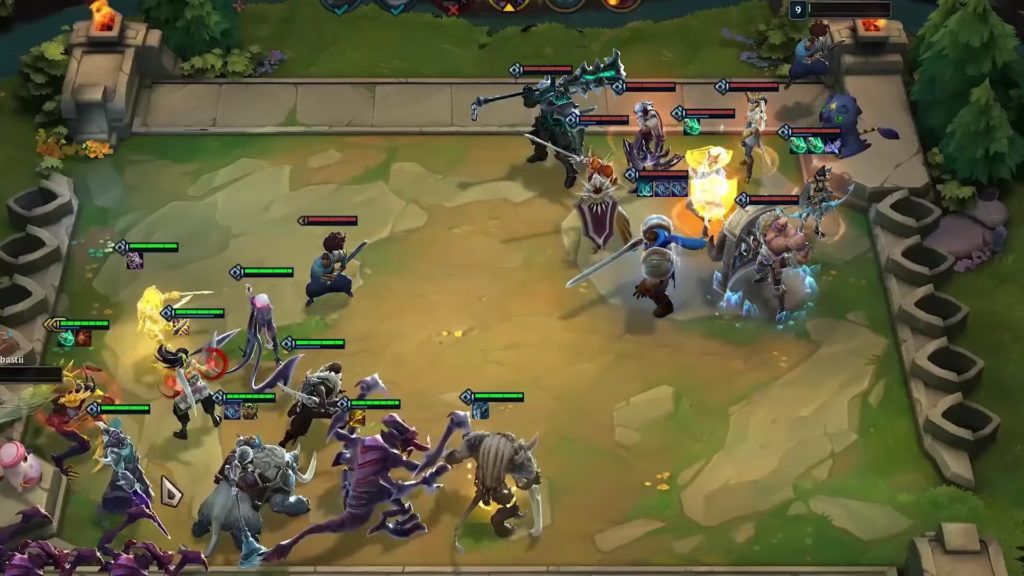
Clumping around the front line units prevents them from moving forward at the start of the round. During this moment, assassins have stealth. The enemy front line will move further in to engage with the visible units and open up space for your assassins to attack
The key to good positioning is flexibility. Don’t forget to check your opponent’s field to observe how their units are positioned. Make use of that knowledge to shift units, opening up as much space as possible for the damage dealers to carry you to victory.

